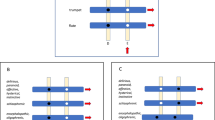Abstract
Neuroscience studies into psychiatric disorders generally rely on disease definitions that are based on the influential Diagnostic and Statistical Manual of Mental Disorders (DSM), the fifth edition of which (DSM-5) was released earlier this year. Designed as a purely diagnostic tool, the DSM considers different disorders as distinct entities. However, boundaries between disorders are often not as strict as the DSM suggests. To provide an alternative framework for research into psychiatric disorders, the US National Institute of Mental Health (NIMH) has recently introduced its Research Domain Criteria (RDoC) project. In the RDoC, five 'domains' each reflect a brain system in which functioning is impaired, to different degrees, in different psychiatric conditions. Nature Reviews Neuroscience asked six leading investigators for their thoughts on how DSM-5 and the RDoC will influence neuroscience research into psychiatric disorders.
This is a preview of subscription content, access via your institution
Access options
Subscribe to this journal
Receive 12 print issues and online access
$189.00 per year
only $15.75 per issue
Buy this article
- Purchase on Springer Link
- Instant access to full article PDF
Prices may be subject to local taxes which are calculated during checkout
Similar content being viewed by others
References
Kupfer, D. J., Kuhl, E. A., & Regier, D. A. DSM-5 — the future arrived. JAMA 309, 1691–2169 (2013).
Kupfer, D. J., & Regier, D. A. Neuroscience, clinical evidence, and the future of psychiatric classification in DSM-5. Am. J. Psychiatry 168, 672–674 (2011).
US National Institute of Mental Health. Strategy 1.4 of the 2008 NIMH Strategic Plan. Sec1:9. nimh.nih.gov[online], (2008).
Cuthbert, B. N., & Insel, T. R., Toward the future of psychiatric diagnosis: the seven pillars of RDoC. BMC Med. 11, 126 (2013).
Soliman, F. et al. A genetic variant BDNF polymorphism alters extinction learning in both mouse and human. Science 327, 863–866 (2010).
Felmingham, K. L., Dobson-Stone, C., Schofield, P. R., Quirk, G. J., & Bryant, R. A. The brain-derived neurotrophic factor Val66Met polymorphism predicts response to exposure therapy in posttraumatic stress disorder. Biol. Psychiatry 73, 1059–1063 (2013).
Author information
Authors and Affiliations
Corresponding authors
Ethics declarations
Competing interests
Steven E. Hyman is a consultant of the Novartis Science Board, Astra Zeneca Neuroscience Innovative Medicines Unit, Fidelity Biosciences (venture) Scientific Advisory Board. B. J. Casey, Nick Craddock, Bruce N. Cuthbert, Francis S. Lee and Kerry J. Ressler declare no competing financial interests.
Rights and permissions
About this article
Cite this article
Casey, B., Craddock, N., Cuthbert, B. et al. DSM-5 and RDoC: progress in psychiatry research?. Nat Rev Neurosci 14, 810–814 (2013). https://doi.org/10.1038/nrn3621
Published:
Issue Date:
DOI: https://doi.org/10.1038/nrn3621
This article is cited by
-
Comparing the Approaches and Validity of ICD-11 Criteria for Gaming Disorder and DSM-5 Criteria for Internet Gaming Disorder
Current Addiction Reports (2022)
-
Dissecting diagnostic heterogeneity in depression by integrating neuroimaging and genetics
Neuropsychopharmacology (2021)
-
Transdiagnostic dimensions of psychopathology explain individuals’ unique deviations from normative neurodevelopment in brain structure
Translational Psychiatry (2021)
-
Zwölf Jahre Research Domain Criteria in der psychiatrischen Forschung und Praxis: Anspruch und Wirklichkeit
Der Nervenarzt (2021)
-
Computational approaches and machine learning for individual-level treatment predictions
Psychopharmacology (2021)



